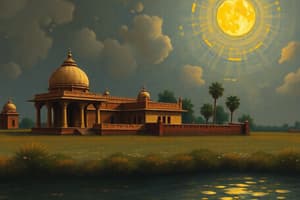Podcast
Questions and Answers
What does the word 'veda' translate to?
What does the word 'veda' translate to?
- To hear
- To write
- To know (correct)
- To see
Which collection forms the core of the Vedic texts?
Which collection forms the core of the Vedic texts?
- The Brahmanas
- The Aranyakas
- The Upanishads
- The Mantras (correct)
Which of the following is not one of the four main Vedas?
Which of the following is not one of the four main Vedas?
- Atharvaveda
- Bhagavad Gita (correct)
- Samaveda
- Rigveda
What is the primary purpose of the Brahmanas?
What is the primary purpose of the Brahmanas?
Which term refers to the philosophical discussions appended to the Brahmanas?
Which term refers to the philosophical discussions appended to the Brahmanas?
The Vedic texts together with their Brahmanas are collectively known as what?
The Vedic texts together with their Brahmanas are collectively known as what?
What do the Aranyakas literally translate to?
What do the Aranyakas literally translate to?
Which Vedic text is considered to be the end of the Veda?
Which Vedic text is considered to be the end of the Veda?
What period marks the decline of the Harappan civilization?
What period marks the decline of the Harappan civilization?
Which group is known to have migrated in the Vedic period?
Which group is known to have migrated in the Vedic period?
Flashcards are hidden until you start studying
Study Notes
The Vedic Age Overview
- Transition from the Harappan Civilization marked by urban decline around 1900 BC and emergence of rural settlements.
- Arrival of new groups called Aryans or Indo-Aryans coincided with Harappan decline, offering archeological evidence of migration.
- Vedic Age spans from 1500 BC to 600 BC, characterized by development of distinct cultural and societal features.
Objectives of Study
- Understand Vedic texts and their content.
- Identify Aryan migration regions and their early settlements.
- Differentiate between Early Vedic (1500 BC-1000 BC) and Later Vedic (1000 BC-600 BC) societies.
- Recognize the significance of iron implements in Later Vedic society.
- Examine changes in economic, social, religious, and political structures from 1000 BC to 600 BC.
Vedic Texts
- The term "Veda" derives from the root "vid," meaning "to know," indicating sacred knowledge contained within.
- Vedic literature consists of two main categories: Mantras and Brahmanas.
- Mantras: Core texts of Vedic literature, divided into four collections:
- Rigveda
- Samaveda
- Yajurveda
- Atharvaveda
- Brahmanas: Prose texts that explain mantras and sacrificial rituals, not to be confused with the Brahminical class.
- Mantras: Core texts of Vedic literature, divided into four collections:
- Together, the Vedas and Brahmanas are referred to as "shruti," meaning "that which was heard," indicating their divine origin as perceived by sages.
Additional Texts
- Aranyakas: Known as "forest writings," serve primarily as appendices to the Brahmanas.
- Upanishads: Philosophical discussions termed "Vedanta," meaning "end of the Veda," representing the culmination of Vedic thought.
Studying That Suits You
Use AI to generate personalized quizzes and flashcards to suit your learning preferences.




